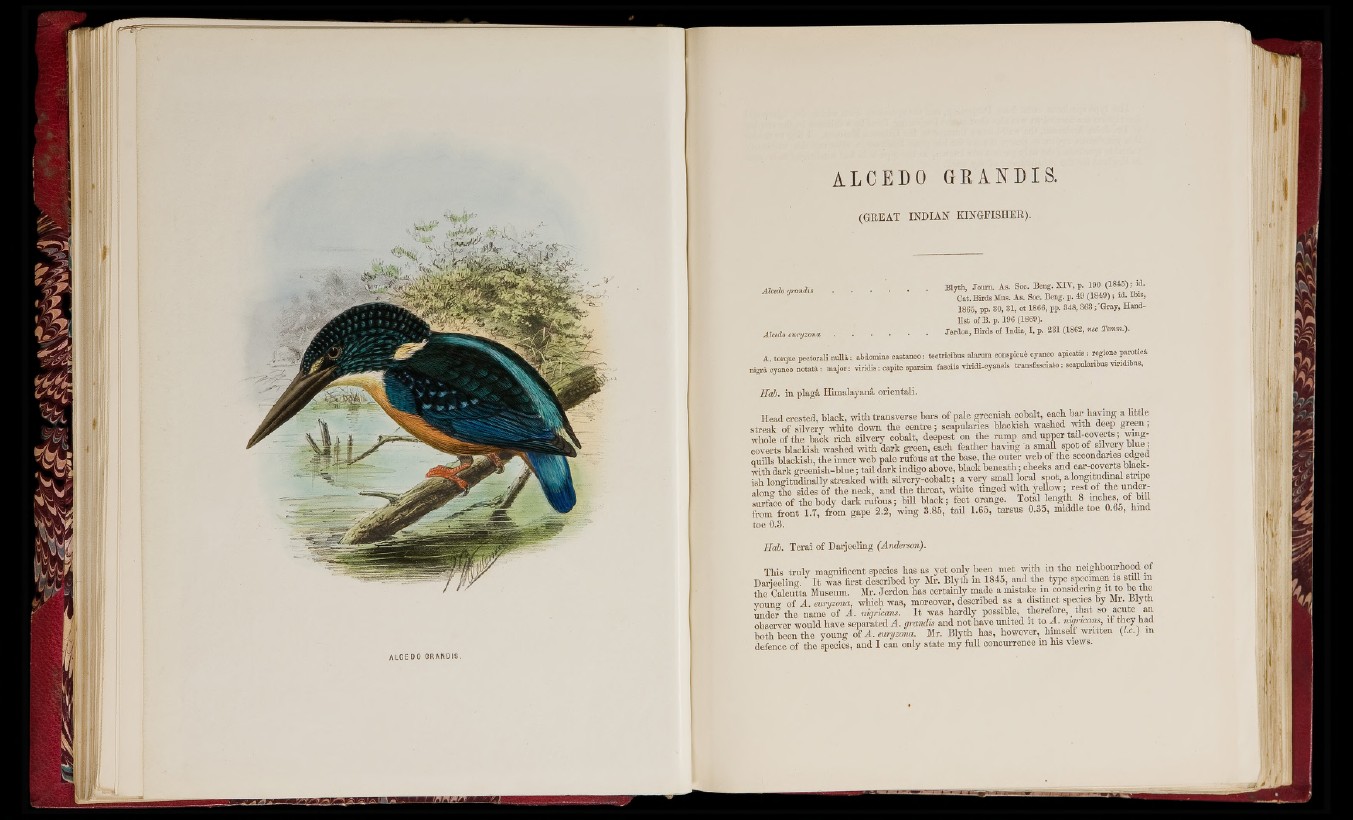
ij lili
f riiji
/ p r
A L C E DO GRANDI S .
I I i i i
i i i i'
ALCEDO GDANDI S .
(G R EA T IN D IA N K IN G F ISH E R ).
Ah .,U ...............................................Blyth, Joum. As. Soc. Beng. XIV, p. 190 (1 845); id.
Cat. B irds Mus. As. Soc. Beng. p. 49 (1849) ; id. Ibis,
1865, pp. 30, 31, e t 1866, pp. 348,363 j'G i'ay , Han d -
Hst of B . p. 196 (1869).
A hedo e u r y z o n a .....................................................Je rdon, B ird s of India, I , p. 231 (1862, t a . ) .
A torque peetoraH nulla : abdomine castaneo ; tectricibus alarum conspicuè cyaneo apic a tis: regione parotica
nigrà cyaneo nota ta : m a jor: viridis : capite sparsim fasciis viridi-cyaneis transfasciato : scapulai-ibus n rid ib u s ,
Hcd. in plaga Himalayana orientali.
Head crested, black, with tran sv erse bai*s o f pale greenish cobalt, each bai’ hav in g a little
streak o f silvery white dotvn the centre ; scapularies blackish washed w ith deep green ;
whole o f the back rich silvery cobalt, deepest on the rump " P P ® ® 3
coverts blackish washed w ith d a rk green, each leath er having a small spot o f silv eiy blue ,
quills blackish, the in n er web pale rufous a t th e base, the outer web of the secondaiies ed^ed
with dark g reenish-blue ; tail d a rk indigo above, black beneath ; cheeks m d ear-coverts b l ^ k -
iah longitudinally streaked Lvith silvery-cobalt; a v e ry smaU loral spot, a l o n p tu i ^ a l s ^
alonv the sides of th e neck, and th e thro at, white tinged with yeUow; re s t o f th e undei -
surface o f the body d a rk ru fo u s; bill black ; feet orange. Total len g th 8 inches, o f M l
from fro n t 1.7, from gape 2.2, wing 3.85, tail 1.65, tarsus 0.35, middle toe 0.65, hin d
toe 0.3.
Hah. Te rai of Darjeeling (Anderson).
This tru ly maonificent species has as y e t only been m et with in the neighbourhood of
Darieeling. I t was first described by Mr. B lyth iu 1845, and th e type specimen is still in
th e Calcutta Museum. Mr. J e rd o n has certainly made a mistake in considering i t to be the
vouno- o f A . eun/zona, which was, moreover, described as a d istin c t species b y Mr. lily th
unde? the name o f A . nkjricam. I t was h a rd ly possible, therefore, th a t so acute an
observer would have separated A . grandis and n o t have u n ited it to A. ntgnmns, if they h.ad
b oth been th e y oung o f A. eaiT/OTia. Mr. B ly th has, however, himself w ritte n (I.e.) in
defence of the species, and I can only sta te my fuU concurrence m his views.
I I